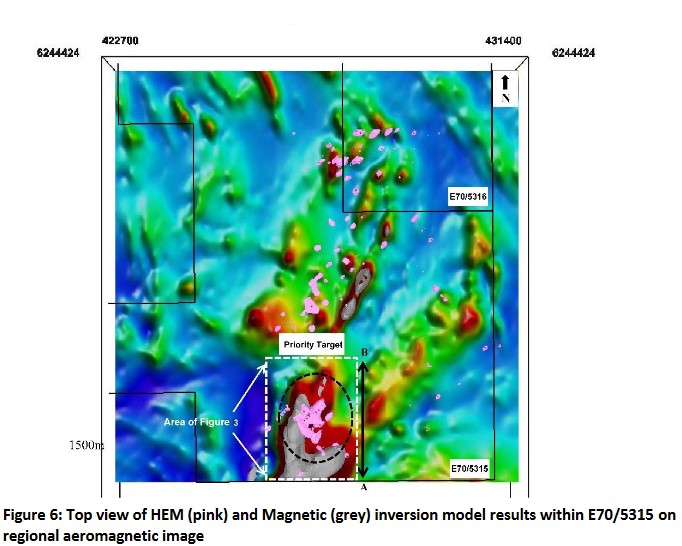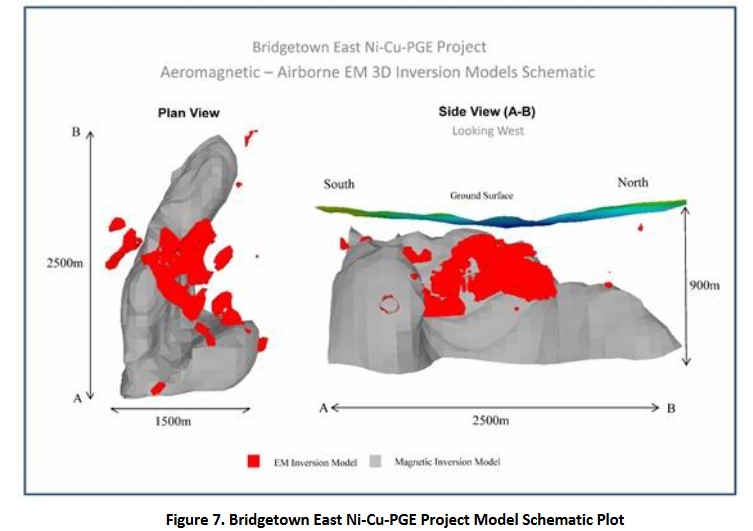Venus Metals Corporation Limited (“VMC”) subsidiary ("Venus Subsidiary") has entered a binding transaction with a subsidiary (“IGO Subsidiary”) of IGO Limited regarding exploration and, if warranted, development and mining at its Bridgetown Greenbushes Exploration Project ("Project"). IGO holds a 49% interest in a global joint venture with Tianqi Lithium Corporation. The joint venture has a 51% interest in the Greenbushes Lithium Mine. Farm-in and Joint venture in which IGO Subsidiary can progressively acquire up to a 70% interest in the Bridgetown Greenbushes Exploration Project by incurring A$6,000,000 of exploration expenditure on the Project.IGO Subsidiary will solely fund all Joint Venture expenditures until the completion of a pre-feasibility study in relation to the Project. If IGO Subsidiary completes a pre-feasibility study, it has the right to acquire Venus Subsidiary's 30% interest in the Project for a price based on fair market value. Should IGO Subsidiary elect not to acquire the 30% interest, the parties will continue to be associated in an unincorporated joint venture under which the IGO Subsidiary must use reasonable endeavours to market and process all Joint Venture products, including Venus Subsidiary's share. IGO Limited is subscribing to 9,000,000 fully paid ordinary shares in VMCat $0.23c per share.
PROJECT BACKGROUND:
VMC’s Greenbushes East Lithium and Bridgetown East Ni‐Cu‐PGE Projects comprise five granted tenements held by Venus Subsidiary, E70/5315, E70/5316, E 70/5620 and E70/5712, E 70/6009 (Venus Subsidiary) and one exploration application, E 70/5675 (VMC) outside of map area of Figure 1. GREENBUSHES EAST LITHIUM PROJECT Targets for potential LCT - rare metal pegmatites The western boundary of the VMC and Venus Subsidiary tenure abuts the Greenbushes mining leases (Figure 1). Geological mapping and reconnaissance surface sampling by VMC within an area of potassic alteration (>9 km2 ) (Figure 2) located pegmatite outcrops with one pegmatite sample returning 0.28% Li2O (refer ASX release 26 June 2017). Systematic geochemical surveys across the western part of E 70/5315 are planned to identify potential LCT targets under soil cover.
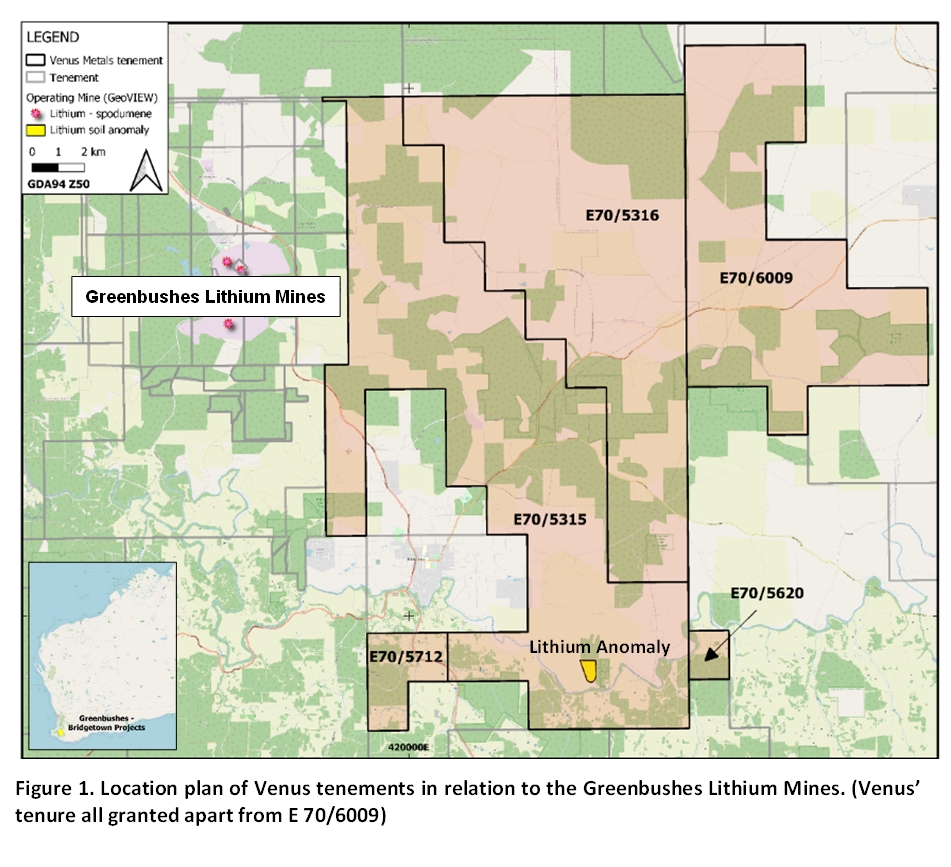

In the south of E 57/5315 an ultrafine soil (UF) survey completed by Venus discovered a strong lithium (Li) anomaly, approx. 20 km southeast of the Greenbushes Lithium Mine (refer to ASX release 9 March 2022) (Figure 3). Significantly, this Li anomaly (maximum 148ppm) is associated with elevated tin (Sn), elevated tungsten (W), and tantalum (Ta) concentrations adjoin the Li anomaly to the west. The Li anomaly, located within a distinct low in the regional aeromagnetic data, measures approx. 300m x 400m and remains open to the north. North-northeast of the soil anomaly and along the general lithological trend of quartz-mica schist is a historical Sn anomaly in laterite (Figure 3) that measures approximately 5km in length and 1-3km in width, based on data from the CSIRO-AGE database (Grunsky, 1991 and GSWA, 1998) and Venus laterite samples (refer ASX release 7 December 2020); this Sn anomaly remains unexplained and untested. The c. 6km long north-northwest geochemical trend of Sn in laterite and a distinct Li anomaly in ultrafine soil to the south present a compelling target for rare metals and LCT pegmatite exploration. Regional geochemical surveys across the tenement area and drill testing of existing anomalies are planned.

BRIDGETOWN EAST NI-CU-PGE PROJECT
Multiple geochemical & geophysical targets for Julimar-style mineralization The Bridgetown East Ni-Cu-PGE Project falls within the West Yilgarn Ni-Cu-PGE Province (Figure 4) first outlined by Chalice Mining Limited (refer to CHN ASX release 4 May 2021) that covers an area of c. 1,200km X 100km and extends from the Narryer Terrane in the north to the Southwest Terrane in the south. Venus’ Bridgetown East Ni-Cu-PGE project (refer ASX release 24 September 2021) abuts Chalice’s and Venture Minerals’ Southwest Project (refer VMS and CHN ASX releases 21 July 2020) (Figure 5)
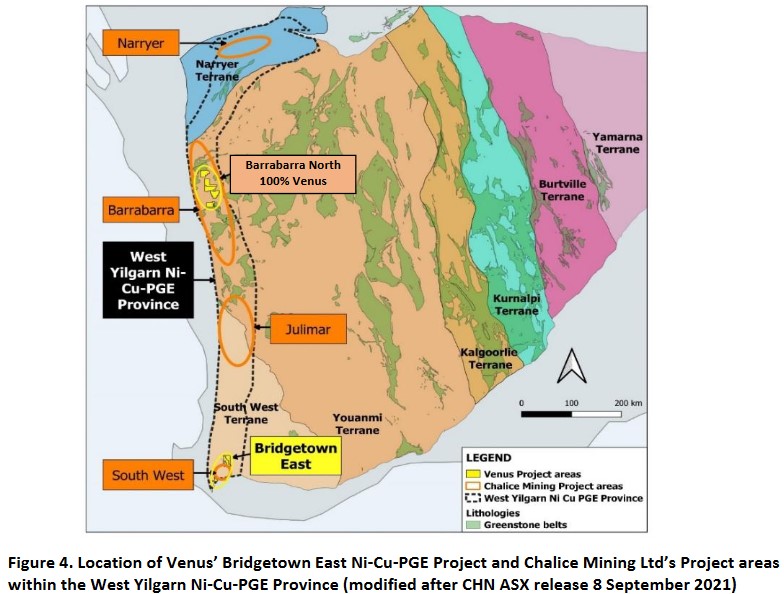
Geophysical Survey Results
A historical Heliborne Electromagnetic (HEM) survey (refer ASX 27 September 2018) indicated a conductor closely associated with a strong magnetic anomaly that appears to be the northern extension of the Thor Target magnetic trend. A review and remodelling of the geophysical data, including a new 3D inversion of the magnetics, further highlights a coincident HEM/magnetic target (refer to ASX release 1 October 2020) (Figures 6 & 7) that is considered a priority for follow‐up work. This priority target is characterised by a discrete HEM anomaly, and conductivity inversion model evident over 300m, located along the strong magnetic anomaly interpreted to represent the extension of the Thor magnetic trend. The HEM inversion model is outlined by an anomalous average conductivity of 10mS/m located approximately 100m from the surface and suggests a dip to the east and plunge to the north. The magnetic anomalies are similar to previously mapped ultramafic bodies (Wamex report A5170). IGO intend to conduct Electro-Magnetic (EM) ground geophysical surveys using the deep penetrating SQUID System over selected target areas.
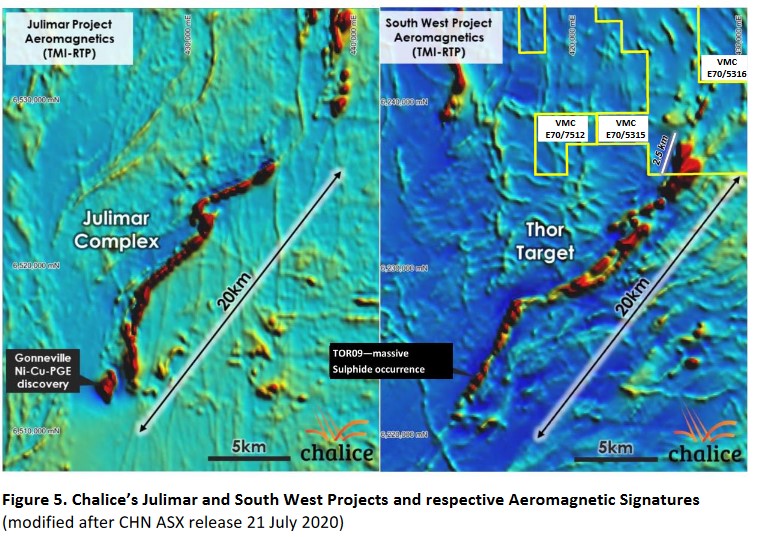
Initial surface geochemistry (rock chip and laterite data) combined with historical data identified several target areas (Figure 8) for potential mafic-ultramafic hosted Ni-Cu-Pt-Pd mineralization. One of these areas, Target 1 in the east of E70/5315, coincides with an aeromagnetic high and a HEM anomaly (refer to ASX release 7 December 2020). Three phases of soil sampling detected anomalous concentrations of Pt, Pd and base metals (in the ultrafine soil fraction) in Target Area 1 (refer to ASX release 29 April 2021), where mafic-ultramafic intrusive rocks crop out nearby. Target 5 is an additional priority target for base metals - PGE mineralization (refer to ASX release 24 Sept 2021). Further sampling extended the Pd anomaly at Target 1 to c. 900m in length and expanded the existing Cu and Ni anomalies (refer to ASX release 29 April 2021) in width and length. At Target 6, the survey confirms historical soil and lag data by Amerod Holdings Pty Ltd (Wamex report A79877), outlining a c. 400m long Cu-Pd-Pt anomaly. Tin and Pt results (Figures 3 & 8) include 61 ultrafine soils taken along public roads on E70/5620 and E70/5315 (refer to JORC Table 1). The priority geochemical anomalies, Targets 1, 5 and 6, warrant ground electromagnetic surveys using the deep penetrating SQUID System to identify potential bedrock sources of the base metals and PGE surface anomalies for drill testing.
